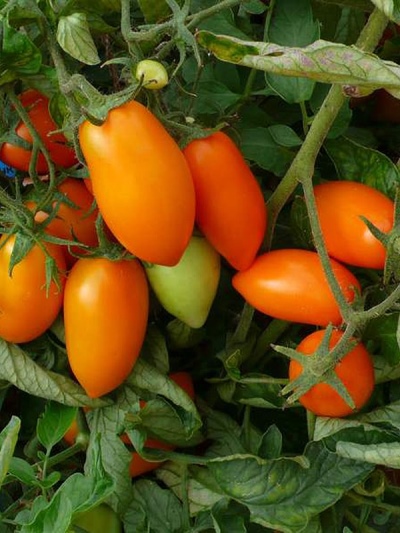
- Authors: Ivanova T.E., Vasiliev Yu.V., Pushkareva N.V., Zverkova V.G., AO Agricultural breeding and production enterprise 'SORTSEMOVOSCH'
- Year of approval: 2007
- Name synonyms: FOXY
- Category: grade
- Growth type: determinant
- Appointment: universal, for whole-fruit canning
- Ripening period: mid-early
- Ripening time, days: 100-110
- Growing conditions: for open ground, for film greenhouses
- Marketability: Yes
Such a funny and even childish part of the name adjusts to a playful mood. But you need to understand that growing tomatoes is a serious matter and requires thoroughness. Therefore, it is extremely important to collect as much information as possible about planting Chanterelles and caring for her in order to get the best result.
Breeding history
Chanterelle has been allowed to grow in private gardens since 2007. It was created by the employees of the selection and production enterprise "Sortsemovosch". It is known that 4 large selection specialists were involved in the work.
Description of the variety
The plant is suitable for both open field and greenhouse cultivation. It is a determinant variety with an alternative name Foxy. The height of the bushes is 0.9-1 m. Large green foliage develops on them. There are no signs of standard development.
The main qualities of the fruit
This variety is characterized by a high degree of marketability. When the berries are just forming, they are light green in color. Ripe fruits are orange in color. The shape of an inverted egg is typical for them. For 1 brush, there are from 4 to 6 tomatoes weighing 110-130 g, and 7 such brushes will appear on the main stem.
Taste characteristics
Chanterelle berries are considered a good option for canning whole fruits. They taste excellent in sweetness. The pulp is moderately firm. Although the skin is also firm and smooth, it does not add any unpleasant notes to the taste.
Ripening and fruiting
The chanterelle belongs to the mid-early group of varieties. This culture is able to please with the harvest 100-110 days after the emergence of green shoots. Of course, the specific result varies greatly depending on the cultivation conditions and the condition of the site. But on average, the stated deadlines are met quite confidently. The bushes will bear more and more fruits.
Yield
The ability to collect up to 9 kg of fruits per 1 m2 is declared. It is definitely worth emphasizing that in the specific conditions of a particular vegetable garden, the result may differ significantly. An important role here is played by the quality of the planting material and the performance of work. And also it will be necessary to pay attention to the weather and the condition of the land. Insufficient fertilization or too cold ground can easily diminish all bright hopes.
The timing of planting seedlings and planting in the ground
It is necessary to sow seeds in seedling containers in the last decade of March. This is what the suppliers of planting material insist on. You can transfer seedlings into open ground at the beginning of June - this is the usual time. But it is more correct to check whether the threat of spring frosts has really passed. Sometimes this period passes a little earlier, sometimes a little later, and the climate of the region also plays an important role.

Growing tomato seedlings is an extremely important process, because it largely depends on whether the gardener can harvest at all.All aspects must be taken into account, from seedbed preparation to planting in the ground.
Landing scheme
On 1 "square" of the garden, you can plant 3 such plants. But you can also 4 - if there is a desire to deal with difficulties and complicate care. Everything is at the discretion of the gardeners themselves. A distance of at least 50 cm must be maintained between individual holes.

Growing and caring
Seedling picking is necessary when forming 2 true leaves. Timely watering is necessary for this culture. It is very important to apply mineral fertilizers strictly on schedule, as well as as needed. Prevention of damage by pests and diseases is carried out according to the standard scheme. It involves the periodic use of agents that suppress disease-causing fungi.
30 days after planting in a permanent place, the lower leaves will need to be removed. Mulching is carried out with sawdust or cut grass. Drying out of the earth is categorically unacceptable, but stagnant moisture also produces negative effects. It is worth emphasizing that during the growing season, organic or mineral fertilizing will have to be applied 3-4 times. It is even better if they alternate in order to satisfy the need for all the necessary substances; feeding is timed to flowering and fruit formation.




A plant needs different micronutrients at each stage of growth. All fertilizers can be divided into two groups: mineral and organic. Folk remedies are often used: iodine, yeast, bird droppings, eggshells.
It is important to observe the rate and period of feeding. This also applies to folk remedies and organic fertilizers.


Growing regions
It is justified to plant a chanterelle:
in Moscow and its environs;
in the regions of Siberia and the Far East;
in the Urals;
on the Volga;
in the Black Earth Region and the middle zone;
in the center and north of the European part of the Russian Federation.
Review overview
Overall, this variety receives excellent ratings. The cultivation shows stable results from year to year. The taste of the fruit will delight even the most discerning consumers. However, it is worth considering the likelihood of damage by late blight. In addition, in a number of places it is difficult to buy seeds.

























































































